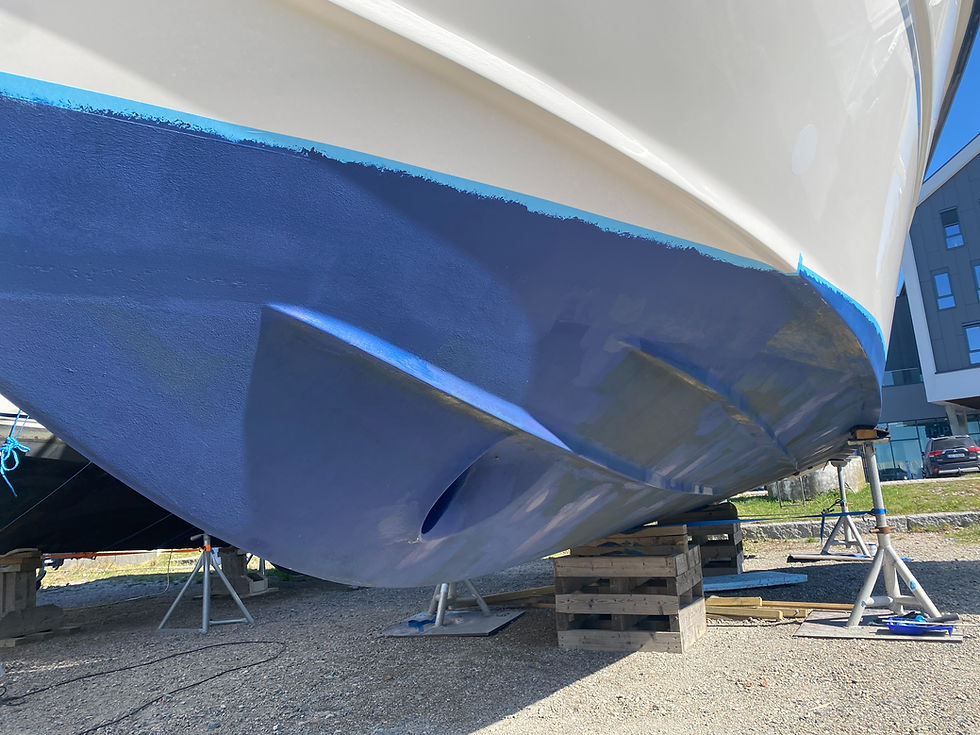Osmosis in Boats and Its Testing: A Comprehensive Guide
- Erinc Aydemir
- Mar 1
- 2 min read
For boat owners, maintaining a vessel’s longevity, safety, and aesthetic appeal is essential. One common issue in fiberglass boats is osmosis—a problem that can affect both the structural integrity and the overall value of the boat. In this post, we’ll explain what osmosis is, why it occurs, and how to properly test for it.
What is Osmosis in Boats
Osmosis in boats refers to the chemical reaction that occurs under the gelcoat of fiberglass vessels, where moisture and ionic substances penetrate the material. Over time, water infiltrates the fiberglass, causing microscopic blisters or swelling. This process can weaken the structure, lead to significant damage, and even affect the boat’s performance if not addressed.
Why Does Osmosis Occur
Several factors contribute to the development of osmosis:
Material Sensitivity: Fiberglass and resin-based materials are naturally sensitive to water. The quality of these materials during production can influence how susceptible a boat is to osmosis.
Environmental Conditions: Exposure to saltwater, prolonged UV radiation, and constant contact with water increase the risk of osmosis.
Lack of Proper Maintenance: Failing to clean and maintain a boat regularly can accelerate surface corrosion and the onset of osmosis.

What is Osmosis Testing
Osmosis testing is a series of inspections and procedures designed to detect signs of osmosis on a boat’s surface. By identifying potential issues early, boat owners can take corrective measures before the problem escalates into costly structural repairs.
How is Osmosis Testing Conducted
Visual Inspection:The first step is a careful examination of the boat’s gelcoat. Look for white, cloudy blisters or swelling, which are common early signs of osmosis. These visual cues help guide further testing.
Water Test (Wetting Test):In this stage, water is applied to suspected areas to assess the material’s hydrophobic properties. The way the water droplets spread or absorb can indicate the presence and severity of osmosis.
Sample Extraction and Laboratory Analysis:If needed, small samples may be taken from affected areas and sent to a laboratory. These tests measure the moisture content and ionic concentrations within the fiberglass.
Advanced Instrumentation:Tools such as thermal cameras or moisture meters can be used to pinpoint areas where osmosis is impacting the structure. These advanced methods provide a more detailed evaluation of the condition.

Key Considerations in Osmosis Detection
Early Diagnosis:Identifying osmosis at an early stage is crucial. The sooner it is detected, the easier it is to manage and repair before it compromises the boat’s overall strength.
Professional Expertise:Conducting osmosis tests should be left to experienced professionals. Their expertise ensures accurate assessments and reliable recommendations.
Regular Maintenance:Preventive measures such as regular cleaning, renewing protective coatings, and periodic inspections can significantly reduce the risk of osmosis and help maintain your boat in prime condition.
Conclusion
Osmosis is a serious concern for fiberglass boats that can lead to substantial damage if left unchecked. However, with early detection and proper testing, the adverse effects of osmosis can be minimized. A comprehensive osmosis test provides invaluable insights into the condition of your boat, helping you plan effective maintenance and avoid expensive repairs in the future.
Investing in regular maintenance and timely osmosis testing not only protects your investment but also ensures safer, more enjoyable journeys on the water. Stay vigilant, and keep your boat in top shape for years to come!




Comments